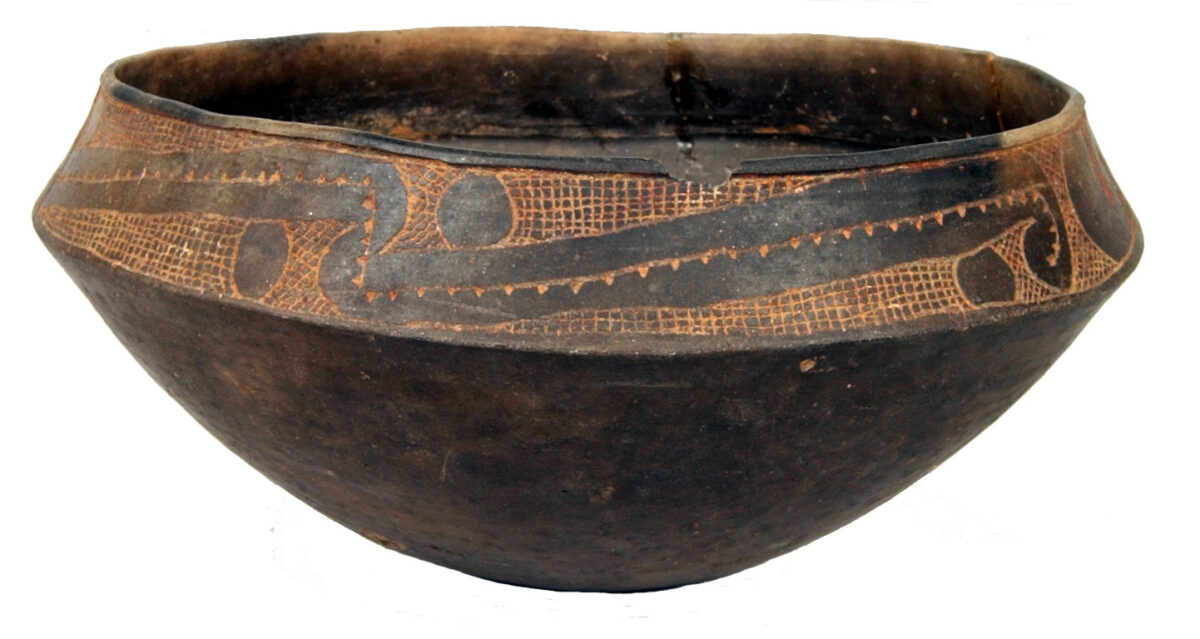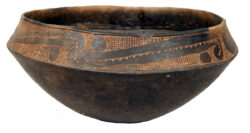Caddo Culture
This entry covers prehistoric Caddo culture during the Late Woodland and Mississippi Periods, 900–1700 CE.

Courtesy of Williamson Museum, Northwestern State University
Caddo Culture Carinated Bowl. Photo courtesy of Northwestern State University and the Louisiana Division of Archaeology
The Caddo people resided in northwestern Louisiana and adjacent portions of Arkansas, Oklahoma, and Texas, between cultures of the Southeast and the southern Plains. In Louisiana, they inhabited portions of the floodplain of the Red River and the adjoining uplands. Their distinctive material culture allows archaeologists to distinguish them from their Plaquemine neighbors to the east and south, and from Mississippian societies in the Mississippi River Valley to the north. Archaeologists can trace Caddo material culture back to at least the tenth century. Although settlement patterns changed through time, most Caddos resided in sedentary villages. In addition to fishing, hunting, and gathering, they cultivated corn and other crops. The Caddos had a hierarchical social organization, and they were great traders, bringing in exotic goods from Mississippian societies as well as from the southern Plains and the Southwest.
Caddo Culture: Definition and Important Sites
Most prehistoric cultures have names that archaeologists ascribed to them. However, the name “Caddo” comes from the historically known Kadohadacho (meaning “real, or proper Caddo”) confederacy, one of three confederacies that incorporated some twenty-five named groups when they were first encountered by Europeans. The Kadohadacho lived along the Red River north of Shreveport. The other two historic confederacies were the Hasinai in the Neches/Angelina drainage in eastern Texas, and the Natchitoches in and around the present city of Natchitoches. Other Caddo-related groups include the Yatasi who lived in the Shreveport area and later in various parts of DeSoto Parish, and the Adai who lived north and west of the Natchitoches area.
A good example of an early Caddo site is the ceremonial center and nucleated village site known as Mounds Plantation, which is located on the floodplain of the Red River in northern Caddo Parish. Mounds Plantation consists of seven earthen mounds arranged around a large plaza. Two or three additional mounds are located on the site periphery. Excavations in one of the mounds during the early 1960s uncovered several human burials in distinctive, deep “shaft” tombs. Political or religious leaders were interred in these tombs, along with other individuals that may have been sacrificed family members, servants, or slaves. Several of the burials contained exquisitely made and decorated pottery vessels, large stone knives, ornaments of wood and copper, and clusters of small stone projectile points. Unlike most high-status Mississippian culture burials, in which grave goods were lavished on individuals, many of the Caddo items during this period were not associated with a specific person, but were placed around the perimeter of the burial area.
Occupation of Mounds Plantation appears to have ceased during the early thirteenth century, when many Caddos in Louisiana settled in villages consisting of small clusters of houses and other facilities such as granaries and drying racks. Some of these villages were spread out along the floodplains of streams for several miles. This shift in settlement pattern may reflect an increasing reliance on maize agriculture and the need for more extensive agricultural fields. Though no longer inhabited, Mounds Plantation may have continued to function as a center where people aggregated from time to time for ceremonies. Small mounds were present in some (perhaps all) of the dispersed floodplain villages, and local populations used these sites as central places for ceremonies. The mounds also served as residences and burial places of community leaders.
The Belcher Mound site, located seven miles north of Mounds Plantation, is a good example of a ceremonial area and mortuary associated with this later settlement pattern. No nucleated village is present at Belcher, but evidence for a dispersed village was present for 1.5 miles downstream of the mounds. Mound construction was complex. At the Belcher site, the Caddos built two unusual domestic structures on the original ground surface. Probably at the death of important individuals, they burned the structures and interred the deceased through the former house floors. After adding a layer of earth to cover the debris from the burned houses, a new house was constructed on each mound summit precisely above the previous house, and a third house was started adjacent to the mounds. Subsequently, the Caddos added more layers to consolidate the mounds into a single earthwork. Throughout the occupation of Belcher, they built at least eight houses on the earthen layers and placed twenty-six burial pits (containing at least forty-seven individuals) in the mound. As at Mounds Plantation, grave goods in the earliest burials were located along the edges of pits. However, in later burials, pottery vessels, marine shell bead necklaces, stone arrow points, bone tools and ornaments, and other items were carefully deposited adjacent to individuals.
Caddo Culture Artifacts
The Caddos created two broad categories of pottery vessels, a fine ware and a utilitarian ware. Many archaeologists consider the fine ware to be the most accomplished pottery ever made in the prehistoric Southeast. This pottery has thin walls, is highly polished, and has complex and precisely executed designs. Adding to their distinctiveness, Caddo potters produced a wide variety of vessel shapes, although the most common forms were deep bowls, carinated bowls (bowls with very strong, angular shoulders), and long-necked bottles. Most of the fine wares appear to have been serving vessels, and likely were important in rituals and ceremonies. Upon the deaths of their owners, these vessels often were buried as grave goods. Utilitarian wares were thicker and coarser, as befit their storage and cooking functions. There was greater uniformity in the form and design of these utilitarian vessels, but they often were decorated, and sometimes they were placed in the tombs. Beginning shortly before the arrival of the first Europeans, the Caddos made small bowls for evaporating salt from briny water that seeped out of the ground in a number of places. Ceramic pipes for smoking tobacco and other herbs also were commonly used by the Caddos.
Pottery was not the only outstanding craft produced by the Caddos. With access (through trade) to a wide variety of stone sources, they made finely polished stone axes (known as celts) and other ground stone objects; they also fabricated beautiful chipped stone ceremonial blades and arrow points. Renowned for their strong bows in historic times, the prehistoric Caddos may also have manufactured and traded bows made from the wood of the Osage orange tree (Maclura pomifera; also called bois d’arc), which was abundant in some parts of Caddo territory. Indeed, a tomb at Mounds Plantation produced an unusual array of organic items, including a bow (the wood is not identified). That tomb also contained more than two hundred small pieces of split-cane matting, some with designs very similar to those woven by the Chitimacha today.
A partial list of other artifacts recovered from this tomb—presumably that of the paramount leader for the Mounds Plantation area—includes a pottery bowl decorated with Mississippian symbols; large knives made of stone from central Texas; ornaments of wood and copper; clusters of stone arrow points; and purslane (Portulaca oleracea) seeds. Also found were four artifacts characteristic of the much earlier Poverty Point culture two stone beads, a broken slate ornament, and a hematite plummet.
Effigy pipes made from distinctive Missouri flint clay, ear ornaments and other objects of copper, and additional items from the Gahagan site in Red River Parish illustrate the complex ties between the Caddos and their Mississippian neighbors. These items likely were brought into the Caddo area from the extensive Cahokia site in southern Illinois near the modern city of St. Louis. One of the effigy pipes depicts a frog holding a ceremonial rattle and relates to other symbols of the mythological underworld common at Cahokia. Two copper ornaments are in the shape of a long-nosed god, who may be related to a culture hero recognized by the historic Winnebago and upper Iowa tribes.
Daily Lives and Deaths
The Caddos raised corn, beans, and squash; they also hunted, fished, and collected wild plant foods such as nuts (hickory, pecan, walnuts, acorns), persimmon, purslane, wild grapes, and berries. Although deer was the most important meat source, fish and turtle were very important in the Caddo diet. The Caddos also hunted rabbit, squirrel, turkey, various small mammals, and birds. Excursions to the southern plains to hunt bison occurred during the eighteenth century when the Caddos had horses, but archaeologists have not found bison bone in prehistoric Caddo archaeological sites in Louisiana.
The burials described above were of the elite. Ordinary people were buried soon after death in single graves. Sometimes a few offerings were included. The graves may be in a family cemetery, although children were often buried in graves dug through house floors. Some adults also received this treatment.
Final Thoughts
Caddos in southern Arkansas and northeast Texas were visited by the Spanish of the de Soto Expedition (1539–1543). The Louisiana Caddos were spared any prolonged contact with Europeans until colonization began in 1699. Nevertheless, in the interval between de Soto and French settlement, all Caddos had suffered to some degree from disease and population decline. But the Caddos adapted. By 1700, many Caddos already had horses, peach groves, and watermelon patches. Possibly because of their long success as traders, their culture survived. The modern Caddo Nation has its headquarters near Binger in west central Oklahoma. Some Caddos, descendants of the Adai group, continue to reside in Louisiana.
